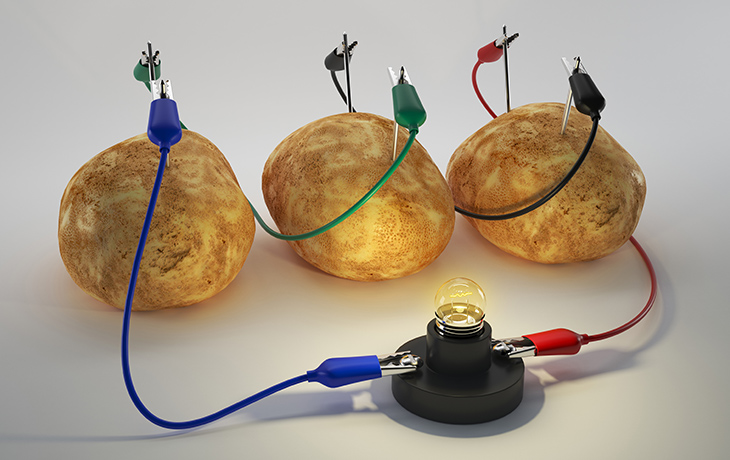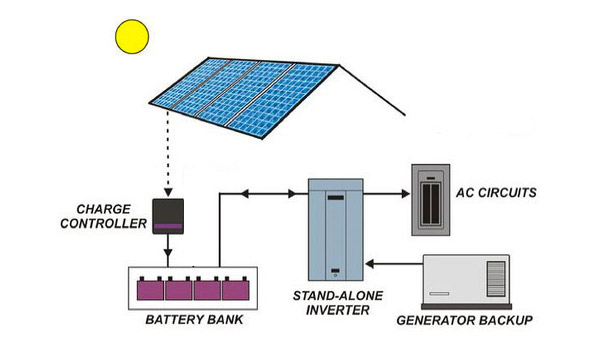Figuring out how to keep your gear running without the grid can be confusing. Just understanding the terminology is difficult enough, and after you figure out the basics, you still have to piece together a system that meets your specific needs and budget.
Good news: You don’t need an advanced degree. Just a few simple definitions and a lay of the land will guide your power preparedness.
Summary:
- Think of the products in these markets in three buckets: portable (hiking), semi-portable (driving to basecamp), and fixed (roof installations).
- The simplest off-grid power solution is just a high-capacity battery that you charge beforehand.
- Even when things get more complicated than that, a battery will almost always be a part of the chain (even if it’s built into the device you want to use), acting both as storage and to smooth out wobbly supply from a generator.
- So when you’re putting together your off-grid kit you should figure out your battery needs first, then build from there.
- Always buy the biggest battery your budget and mobility needs will accommodate, because bigger batteries drain more slowly (even when the device draw is the same).
- The energy that goes into a battery has to come from somewhere. If not from the grid, then you have to convert your own solar or rotational energy into electrical current.
- Solar is the best renewable power supply, winning across every metric like cost, efficiency, and convenience.
- Technology is rapidly improving in all fields, but wind-, water-, and crank-powered devices just aren’t good enough yet for most personal needs — the exceptions are crank-powered lights and radios in a backup role.
- Gas-powered generators are another option, obviously limited by portability and the amount of fuel available.
- You don’t need to worry about advanced gear and concepts like inverters, charge controllers, or AC vs. DC until you get into larger installations (eg. a house roof).
Putting the right gear together for your needs is generally broken up by the type of devices you need to power (e.g. your phone or space heater) and how portable you want to be (home vs. vehicle vs. go bags).
Devices and the gear needed to power them tend to stay in the same portability category. A cell phone is portable, so it can generally pair with a portable battery and generator. A space heater is technically portable, but you’d just carry it around the house or in your car to a basecamp, so it pairs with semi-portable power. Your full-sized kitchen fridge is fixed, so it needs a large fixed solar and battery installation in your home.
Products tend to stay in those lanes due to the nature of how electricity works. A phone, for example, already has a built-in battery, can charge via a simple USB cable and DC power, and doesn’t require a ton of juice to run. On the other hand, your laundry machine requires a lot of steady AC current and doesn’t have its own battery.
More:
- Best portable solar chargers
- Best portable power banks
- Best removable rechargeable batteries
- Best removable battery chargers and testers
- Beginner’s guide to removable battery types and which are best for prepping
Why you can trust me
In addition to an electrical engineering degree, I’ve written a book on an engineering-related topic and have spent years reviewing batteries, solar panels, chargers, and related gear, both in a general context and specifically for preparedness.
Be prepared. Don’t be a victim.
Want more great content and giveaways? Sign up for The Prepared’s free newsletter and get the best prepping content straight to your inbox. 1-2 emails a month, 0% spam.
Example setups
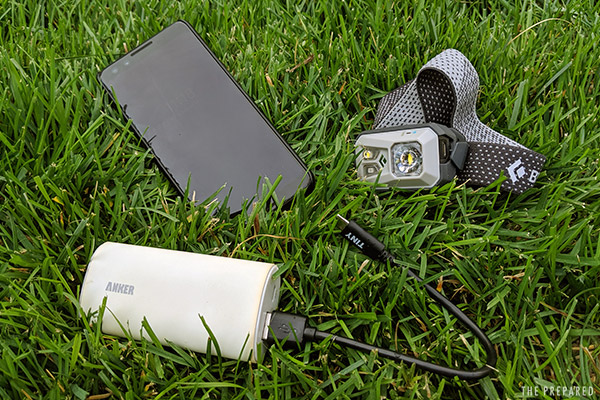
For powering small USB gadgets, like mobile phones and headlamps, compact lithium-ion battery banks can hold most of their power for weeks (especially if kept cool). This is the easiest and lightest way to recharge your handheld devices 1-3 times. The downside is you are limited to the power already stored in the battery pack.
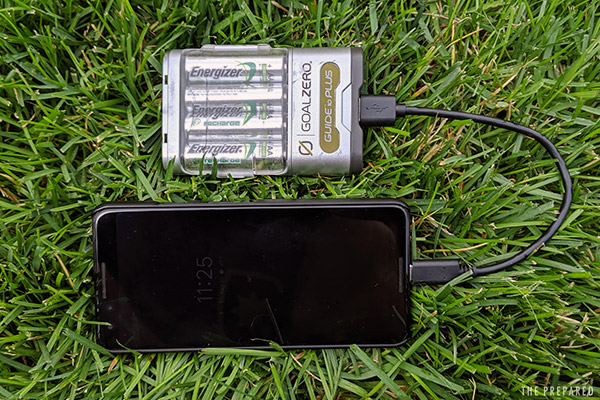
There are a few products that can both recharge removable AA/AAA batteries via a generator and use those batteries as a power bank to charge external USB devices (as shown). Charging removable batteries is key for devices that don’t have their own internal batteries.
This method works great as a backup — especially since a good prep kit has quality AA-family batteries in it, anyway, and you’re likely to find more in an emergency — but should not be your primary choice because AA-types don’t perform as well as Li-Ion packs for energy density. In practice, that means you get 50% less energy for 50% more weight. That may not be enough to complete a full charge cycle on beefier phones. So you’d rather recharge your devices from a Li-Ion pack, if possible.
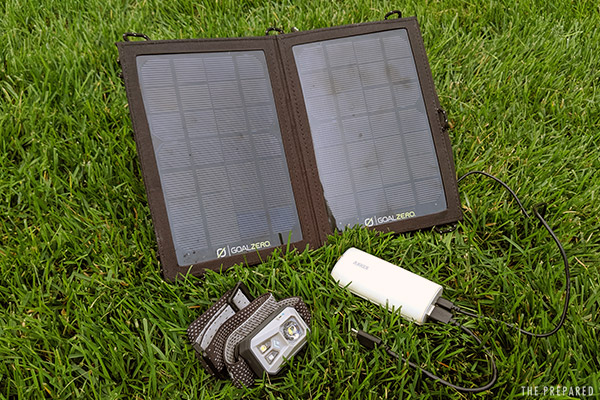
Broadly speaking, the above popular power setup can keep your core portable devices (phone, light, radio, etc.) charged indefinitely. The portable solar panel can charge removable batteries (like the previous AAx4 pack) or Li-Ion batteries. You can also charge devices with built-in batteries (like this headlamp) directly from the panel. Since you should try to charge external power packs first, then power your devices from that pack, you can get by with one cable if needed and all the devices use the same type (almost everything is USB-B or -C these days).

This semi-portable setup can be moved by hand over short distances around the house or to/from a car. It can certainly charge the smaller batteries, battery packs, and devices. But it shines for larger batteries used to power medical devices (shown), small heaters and fridges, car jump starters, power tools, ham radio base stations, etc.
It won’t keep your whole household running indefinitely, but can keep the important stuff running when it counts.
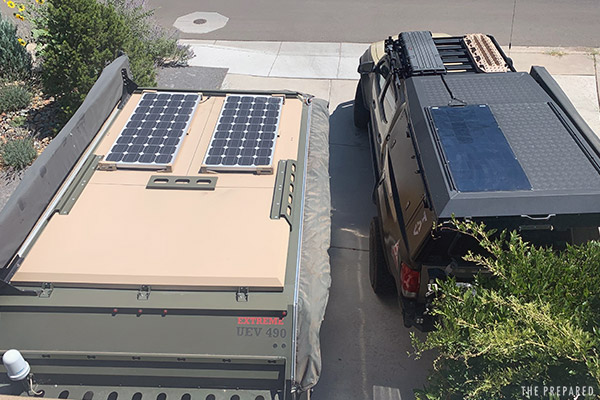
Some bug out vehicles, RVs, boats, etc. have fixed installations for constant power, with panels on the roof and charge controllers, inverters, and batteries in a trunk/compartment. One of our personal trucks, shown, uses this setup to power multiple tablets, lights, and a mobile refrigerator to keep medical supplies cool. The gas engine can also support the batteries if there’s a few cloudy days in a row.

Some buildings are hard-wired to automatically switch over to a fixed or semi-portable generator and battery setup when the main grid goes down. The generator power seamlessly flows through the normal building circuits. This is a popular middle-ground choice for people who don’t want full-time solar but need to keep things running in an emergency. Assuming the generator is sized appropriately, your only limit is gas.
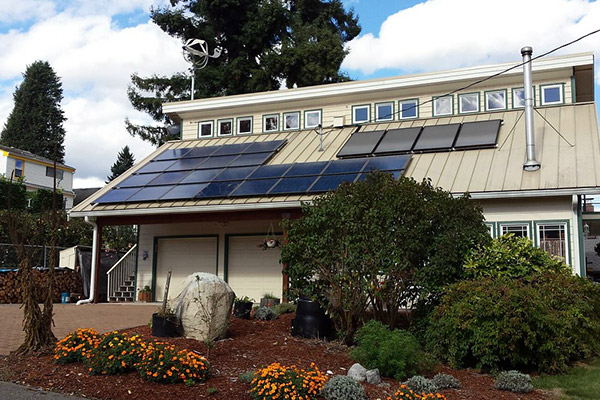
Buildings that are primarily or permanently off-grid have a fixed installation of large batteries and generators (solar panels, wind turbines, gas generators) plus extra components like an inverter and charge controller. These setups can get more complex if you wish to sell extra energy back into the grid, have extra backup systems, and so on.
Common terms and AC vs. DC
Batteries store energy. Generators create energy.
Direct current (DC) is a natural, simple flow of electricity in one direction, like water from a hose. Many portable devices are powered directly by DC from a battery or a wall adapter. DC’s main drawback is that it loses power as it’s transmitted over longer cables, which is why charging cables are always shorter than you want them to be.
Alternating current (AC) is what comes from your wall outlet. Unlike DC power, AC rapidly alternates back and forth between positive and negative voltage, so a 120 V outlet (the standard in US homes) actually bounces between +120 and -120 volts with a frequency of 60Hz.
Inverters turn simple DC into complex AC. More robust products, like a mini fridge, require the kind of AC current that comes out of your wall socket. A DC battery itself won’t power those products, requiring an inverter in between. Although AC solves the line-length problem with DC, you do lose some power through the conversion.
Charge controllers are like babysitters for a battery. There are lots of different battery chemistries out there, each with their own quirks about how they like to be charged. Yet many generators are “dumb”, so they don’t know when to turn off the supply. The charging controller prevents the battery from overcharging, overheating, etc. Portable devices often have a built-in controller, while larger fixed installs often have an external one.
Volts are a measure of electrical potential, but don’t worry about really grasping this abstract concept. Instead, you should think of a voltage rating for an adapter, battery, or product — 1.5V, 5V, 12V, 120V, etc. — as a sort of “compatibility rating.” You plug 5V devices into 5V outlets, 12V devices into 12V outlets, and so on. But you do not plug a 12V device into a 5V or 120V outlet, because it simply won’t work. So the voltage number is a label that says, “this is what kind of outlet this is,” or “this is what kind of outlet this device expects to be plugged into,” or “this is what kind of battery this gadget takes.” You have to match up the voltages or the device won’t work.
Amps are a measure of current flow, and unlike voltage they can vary quite a bit from what a device, charger, or outlet is actually rated for. If you plug a tablet that wants 3 amps into a 1.5-amp charger, it’ll just draw 1.5 amps because that’s the maximum the charger can deliver. If you plug a phone that wants 1.5 amps into a 3-amp charger, it’ll just draw 1.5 amps because that’s the maximum the phone can ask for. It’s important to know that outlets do not push amps to devices — rather, devices pull amps from outlets.
Watts are a measure of power or energy, and they’re calculated by multiplying volts times amps. Whenever we use electricity to do work, watts are what we’re really using. Voltage and amperage numbers are more about compatibility and capability, while wattage numbers tell you how much real, working energy a charger can put out or a device can consume.
Ways to create electricity (and why solar is king)
Whether it’s solar, wind, crank, gas, water, or nuclear, most of our usable electricity is generated by one of two methods: solar energy or rotational energy.
Nuclear and coal power plants work by heating water into steam, which then pushes the turbines around in an infinite circle. Hydro dams use the natural force of the water current to spin the turbines. Wind turbines use wind. And so on. Even your car engine works the same way, turning the gas-explosion-powered mechanical piston rotation into electricity.
The basic reason: As magnets and wires spin past each other, an electrical current forms in the wires which can be sent off to be used. Every time you use your hand to turn a crank-powered device, you’re spinning magnets and generating a few electrons with each cycle.
These mechanical devices can work fine at large scale, but they become less useful when shrunk down to something for your home or smaller. A hand crank is generally only acceptable for low-power devices in a backup role — namely lights or radios. Gas-powered generators tend to be the only meaningful non-solar option for homes and large devices, although wind is (hopefully) catching up.
Solar doesn’t use rotational energy, instead using a chemical reaction to turn sun beams into a stream of electrons. Solar has become the king of renewable energy because:
- It’s convenient, can be integrated into other devices, made into flat and foldable panels, etc.
- Huge amounts of solar radiation hit the ground every day.
- You don’t need any additional fuel (gas, water, calories spent on cranking).
- Solar technology has advanced to the point where the value is much greater than the cost.
Batteries are the foundation
The simplest way to power a device without the grid is to have that energy already stored. A small battery rig can recharge simple devices like a phone or headlamp a few times before the energy is drained.
Depending on the device you need to power, that might be in the form of high-quality removable batteries (AA, CR123A, etc.), Li-Ion “battery packs”, or something more robust installed into your home.
Reviews: Removable rechargeable batteries and battery chargers
Batteries also form the foundation of any setup more complicated than that simple “plug your phone into a battery” model. Even when you think you’re powering a device directly — like your phone — you’re often powering the internal battery which then powers the device.
The battery is central to all off-grid power because it acts as a reservoir that smooths out the unsteady flow of electricity from constantly shifting natural sources like sun and wind. These fluctuating renewable energy sources fill the battery with charge in fits and starts, and then that charged battery can power its attached devices with a steady, predictable stream of electrical current at a constant voltage.
Charge standalone batteries before charging your devices
Best practice is to use your generator to charge a battery, then use that battery to charge your devices. Besides the smoother energy flow, this means you can charge your device whenever it suits you. That’s strategically better in an emergency so that your gear isn’t out of commission at the worst times, you’re not limited by sun and weather schedules, you can use that power across multiple devices, and so on.
In any case, you want to keep batteries cool and out of the direct sun. Heat is murder on batteries, so if you’re going to wreck or explode a battery by baking it in the sun, then it’s better to ruin an external replaceable battery than one that’s built-in to your e-reader, phone, or tablet.
Only when your standalone batteries are charged should you consider plugging other devices with built-in batteries directly into the generator.
Off-grid battery chemistries: Li-Ion and lead-acid
There are two basic rechargeable battery chemistries in off-grid power: lithium-ion and lead-acid.
Choosing between the two depends on your budget, the amount of electricity you need to store, and the level of portability you’re looking for. Li-Ion tends to be come in smaller sizes, whereas lead-acid is always on the larger side and is a lot cheaper for storing larger amounts of electricity.
Other chemistry types found in removable batteries, such as NiMH, aren’t offered in sizes and form factors appropriate for these needs.
More: The differences between common battery chemistries
Lead-acid is the type of chemistry found in traditional car batteries. It’s relatively cheap and can be used and abused in ways the more delicate Li-Ion chemistry cannot. But lead-acid batteries are a lot heavier per Watt-hour of capacity, so this chemistry is mostly used for fixed or vehicle-based setups.
This isn’t the place to go into the different lead-acid battery options, but it’s worth knowing a few related terms and concepts so that you can better make sense of online discussions of solar installations:
Deep-cycle batteries: Most batteries, and this includes the lead-acid batteries used in car starters, are not meant to be fully drained and then refilled. But large solar installations — where the battery bank may be drained at night and then refilled during the day — need batteries that can support this kind of “deep cycling,” as it’s called. Hence the market for deep-cycle batteries that are appropriate for use with solar.
Forklift and marine batteries: The batteries commonly used in forklifts or boating applications are also popular for off-grid use, because they are relatively inexpensive deep-cycle batteries.
AGM: This acronym comes up a lot in solar battery talk. It stands for “absorbent glass mat.” It’s a type of lead-acid battery with better weight, reliability, and charging efficiency than other types of lead-acid batteries. Not all AGM batteries are deep-cycle, but deep-cycle AGMs are popular for home solar installations.
Making the most of your off-grid battery capacity
Remember:
- The faster you drain a battery from 100% to 0%, the less of its rated capacity you’ll get and the more of its stored electricity you’ll waste. You only get the rated storage capacity out of a battery if you drain it slowly enough.
- Which means it’s easier to get the rated capacity out of a bigger battery because you can drain it more slowly at a fixed power level.
- When comparing different battery capacity ratings, strongly prefer Watt-hours (Wh) to milliamp-hours (mAh) to keep things apples-to-apples.
Battery capacities are usually described in either milliamp-hours (mAh) or watt-hours (Wh). For example, many smaller devices, including phones and Li-Ion power packs, are usually labeled in the 2,000-4,000 mAh range.
mAh is not a great comparison number because it depends on device voltage. It’s a lot like when you’re shopping for frozen food and you see that a meal takes “10 minutes to cook in the oven” — that’s 10 minutes at a specific temperature. Comparing the marketed cook times of two meals doesn’t matter if you don’t know the stated temps.
In contrast, a watt-hour rating is exactly what it sounds like: it tells you how big of an electrical load, measured in watts, a battery can supply for one hour before running out of charge. So a 100 Wh battery can (in theory, but not in practice!) power a 100-watt light bulb for exactly one hour before it runs totally dry.
The reality of battery chemistry, though, is that the faster you drain a battery the less of its stored energy you can actually get out of it. For example, if you drain a 500 watt-hour battery by plugging a 500-watt desktop computer into it, you won’t actually get a full hour of 500-watt output from it — you’ll get a fraction of that amount of time. But if you drain it over the course of 10 hours by plugging a 50-watt laptop into it, you’ll get most of that 10 hours out of it.
What all of this means in the real world, is that if you want to power a 500W computer for one hour, then you had better buy a 1000-Wh or larger battery so that the battery drains more slowly relative to its size.
Comparing milliamp-hours vs. watt-hours
Fortunately, a basic, usable understanding of the relationship between watt-hours and milliamp-hours only requires a tiny bit of math — it’s just multiplication, and you don’t even have to truly understand the underlying terms.
When you’re looking at a battery pack and you see a mAh rating, what you really need to know is what voltage the internal battery operates at. You plug that voltage into the following formula to get the watt-hours:
(milliamp-hours x volts) / 1000 = watt-hours
So to make the numbers easy, if a 5,000 mAh battery operates at 5V, then you can calculate the approximate watt-hours as follows:
(5,000 mAh x 5 volts) / 1000 = 25 watt-hours
In general, though, it’s best to get a Wh rating from the manufacturer, so that you don’t have to untangle which voltage they were working with when they assigned a mAh rating.
